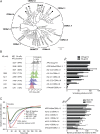Severe adult malaria is associated with specific PfEMP1 adhesion types and high parasite biomass
- PMID: 27185931
- PMCID: PMC4988613
- DOI: 10.1073/pnas.1524294113
Severe adult malaria is associated with specific PfEMP1 adhesion types and high parasite biomass
Abstract
The interplay between cellular and molecular determinants that lead to severe malaria in adults is unexplored. Here, we analyzed parasite virulence factors in an infected adult population in India and investigated whether severe malaria isolates impair endothelial protein C receptor (EPCR), a protein involved in coagulation and endothelial barrier permeability. Severe malaria isolates overexpressed specific members of the Plasmodium falciparum var gene/PfEMP1 (P. falciparum erythrocyte membrane protein 1) family that bind EPCR, including DC8 var genes that have previously been linked to severe pediatric malaria. Machine learning analysis revealed that DC6- and DC8-encoding var transcripts in combination with high parasite biomass were the strongest indicators of patient hospitalization and disease severity. We found that DC8 CIDRα1 domains from severe malaria isolates had substantial differences in EPCR binding affinity and blockade activity for its ligand activated protein C. Additionally, even a low level of inhibition exhibited by domains from two cerebral malaria isolates was sufficient to interfere with activated protein C-barrier protective activities in human brain endothelial cells. Our findings demonstrate an interplay between parasite biomass and specific PfEMP1 adhesion types in the development of adult severe malaria, and indicate that low impairment of EPCR function may contribute to parasite virulence.
Keywords: EPCR; PfEMP1; Plasmodium falciparum; malaria; var.
Conflict of interest statement
The authors declare no conflict of interest.
Figures









References
-
- World Health Organization WHO World Malaria Report 2015. 2015 Avaliable at www.who.int/malaria/publications/world-malaria-report-2015/report/en/. Accessed February 2016.
-
- Anonymous Severe malaria. Trop Med Int Health. 2014;19(Suppl 1):7–131. - PubMed
-
- White NJ, et al. Malaria. Lancet. 2014;383(9918):723–735. - PubMed
-
- Dondorp AM, et al. The relationship between age and the manifestations of and mortality associated with severe malaria. Clin Infect Dis. 2008;47(2):151–157. - PubMed
-
- Miller LH, Baruch DI, Marsh K, Doumbo OK. The pathogenic basis of malaria. Nature. 2002;415(6872):673–679. - PubMed
Publication types
MeSH terms
Substances
Associated data
- Actions
- Actions
Grants and funding
LinkOut - more resources
Full Text Sources
Other Literature Sources
Molecular Biology Databases
Research Materials
Miscellaneous

